Brain biopsy procedure has been evolving for the last four decades in concurrence with the imaging developments of the brain. Frame-based stereotactic interventions are considered the conventional gold reference standard for obtaining biopsy specimens of lesions from the brain. In this modality, a bulky head frame is fixed to the patient’s head before imaging procedures as it is an integral part of a frame based biopsy.
The precision, accuracy, and diagnostic yield given by the rigid frame remain excellent. But there are certain limitations faced in this procedure.
- They include the need to attach headpins prior to obtaining scans for the procedure.
- The discomfort with the bulky frame-based equipment and the calculations involved in deciding the stereotactic entry points with the coordinates.
- The obstruction of the operative field by components of the head frame and inability to navigate the operative field.
- The pre-operative procedural time involved is quite higher in this modality due to fixation of the frame, imaging and calculations required.
- Prolonged surgical time and risk of post-operative infections at the points where the bulky frame was fixed.
- No real-time imaging feedback of the biopsy needle through the brain and location from where the specimen is extracted.
However, the consistent evolution of image-guided surgical operations over the past two decades has led to tremendous advancements in the field of neurosurgery. The development of Frameless stereotactic biopsy procedures gained importance and was embraced by most neurosurgeons due to comparable diagnostic yield, accuracy, and user-friendliness. The frame fixture pins can be avoided and a smaller incision can be made on the patient’s head using the frameless navigation system. In this procedure, the pre-operative image acquired is used for landmark planning and the registration is done on the anatomical prominent landmarks of the patient. The fusion of different radiographic images can be done using navigation software, making it simpler for the surgeon to operate. Dynamic trajectory planning can be done from the entry point to the target lesion making the surgery more target-oriented and less invasive. The real-time imaging of the biopsy needle through the brain with the help of custom trackers assures the surgeon to confidently extract the biopsy specimen. The simultaneous monitoring of the depth and location of the biopsy needle along with the diagnostic accuracy makes this procedure the most reliable.
